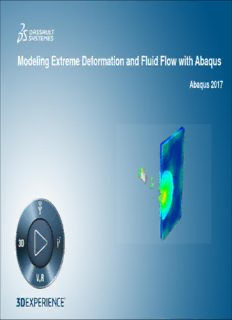
Modeling Extreme Deformation and Fluid Flow with Abaqus PDF
Preview Modeling Extreme Deformation and Fluid Flow with Abaqus
Modeling Extreme Deformation and Fluid Flow with Abaqus Abaqus 2017 About this Course Course objectives Upon completion of this course you will be able to: Create Eulerian meshes and define the initial material location within an Eulerian mesh Specify initial conditions, boundary conditions and loads to materials in the Eulerian domain Use general contact to model Eulerian-Lagrangian interactions Create SPH meshes Automatically convert conventional continuum elements to SPH particles Define initial conditions, boundary conditions, and loads on SPH particles Define contact interactions between SPH particles an element-based or analytical surfaces Understand the differences between the CEL and SPH approaches Targeted audience Simulation Analysts Prerequisites This course is recommended for engineers with experience using Abaqus 2 days Day 1 Lecture 1 Introduction Lecture 2 Overview of CEL (Coupled Eulerian-Lagrangian) Analysis Lecture 3 Creating a CEL Model Workshop 1 Deformation of an Elastic Dam under Time-dependent Water Pressure Lecture 4 Abaqus/CAE Volume Fraction Tool Lecture 5 CEL Modeling Techniques Workshop 2 Bird Strike Impact on Double-walled Aircraft Fuselage Day 2 Lecture 6 CEL for Fluid Applications Lecture 7 Overview of SPH (Smoothed Particle Hydrodynamics) Lecture 8 SPH Modeling Techniques Workshop 3 Bird Strike on an Airplane Engine Blade Lecture 9 Comparison of CEL and SPH Additional Material Appendix 1 SPH Theory SIMULIA SIMULIA is the Dassault Systèmes brand for Realistic Simulation solutions Portfolio of established, best-in-class products Abaqus, Isight, Tosca, fe-safe, Simpack * Included in extended licensing pool SIMULIA’s Power of the Portfolio • Routine and Advanced Simulation • Linear and Nonlinear, Static and Dynamic Realistic Human Simulation Abaqus • Thermal, Electrical, Acoustics High Speed Crash & Impact Noise & Vibration • Extended Physics through Co-simulation • Model Preparation and Visualization • Process Integration Material Calibration • Design Optimization Isight Workflow Automation • Parametric Optimization Design Exploration • Six Sigma and Design of Experiments • Non-Parametric Optimization Conceptual/Detailed Design Tosca • Structural and Fluid Flow Optimization Weight, Stiffness, Stress • Topology, Sizing, Shape, Bead Optimization Pressure Loss Reduction • Durability Simulation Safety Factors fe-safe • Low Cycle and High Cycle Fatigue Creep-Fatigue Interaction Weld Fatigue • Weld, High Temperature, Non-metallics • 3D Multibody Dynamics Simulation Complete System Analyses • Mechanical or Mechatronic Systems (Quasi-)Static, Dynamics, NVH Simpack • Detailed Transient Simulation (Offline Flex Bodies, Advanced Contact and Realtime) Join the Community! How can you maximize the robust technology of the SIMULIA Portfolio ? Go to www.3ds.com/slc to log in or join! SIMULIA Training http://www.3ds.com/products-services/simulia/services/training-courses/ Legal Notices The software described in this documentation is available only under license from Dassault Systèmes or its subsidiaries and may be used or reproduced only in accordance with the terms of such license. This documentation and the software described in this documentation are subject to change without prior notice. Dassault Systèmes and its subsidiaries shall not be responsible for the consequences of any errors or omissions that may appear in this documentation. No part of this documentation may be reproduced or distributed in any form without prior written permission of Dassault Systèmes or its subsidiaries. © Dassault Systèmes, 2016 Printed in the United States of America. Abaqus, the 3DS logo, and SIMULIA are trademarks or registered trademarks of Dassault Systèmes or its subsidiaries in the US and/or other countries. Other company, product, and service names may be trademarks or service marks of their respective owners. For additional information concerning trademarks, copyrights, and licenses, see the Legal Notices in the SIMULIA User Assistance.
Description: